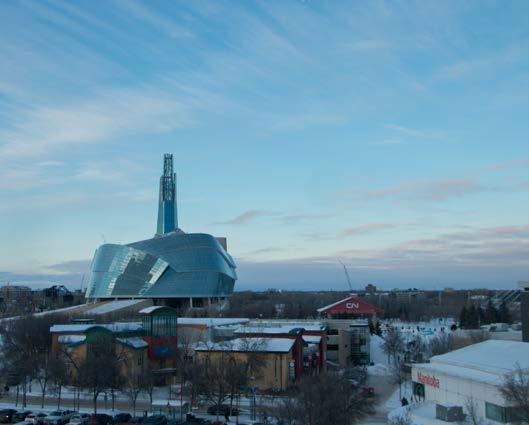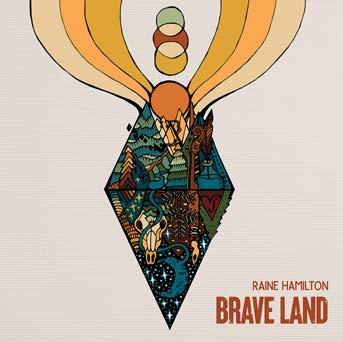
13 minute read
Comment pages 7 and
from 19 January 2022
Stop development projects at the Forks
Heritage site continues to be erased by gentrification
COMMENT
Lucas Edmond, staff The Railside at the Forks development started construction work in August 2021, following the announcement of the project in 2013. The development is planned to include housing, community and business spaces where two parking lots sandwiched between the CN rail line and Israel Asper Way are currently situated. The plots of land are being divided into two communities called Railside North and Railside South.
/ staff Basel Abdelaziz photo /
The reason the project took so long to get going after its announcement was primarily due to financial constraints and bylaws. Finances improved for the Forks’ development after the provincial government opted to renounce $11.9 million worth of property taxes in 2019 to help stimulate the undertaking. Following this decision, in 2020, the City of Winnipeg offered the project $7.9 million in rebate-based subsidies.
After financial support was offered, vice-president of strategic initiatives for the Forks Clare MacKay noted that developers “will be looking at archeology, we’ll be looking at geothermal. Those are the first steps we are taking.”
The Forks hosts one of Manitoba’s largest archeological sites and, following the excavation of the area where the Canadian Museum for Human Rights (CMHR) now sits, archaeologists described it as one of the most important, too. The Forks has been a meeting place for Indigenous people for over 6,000 years and is now a nationally recognized historic and heritage site. As such, between 2008 and 2012, the developers of the CMHR were required to excavate the area in conjunction with the laws laid out by Manitoba’s Heritage Resources Act (MHRA). The act notes an adequate sample of the site is required before construction above those sites. Although the CMHR followed provincial guidelines, only three per cent of the site was excavated.
The site re-confirmed the significance of the Forks to Indigenous history, but it also produced evidence for what is known to have been a massive peace treaty event for Indigenous groups approximately 700 years ago. Scholars who have studied the area suggest nearly 10,000 Indigenous people, spanning from areas as far as southern Minnesota, northwestern Ontario and northern Manitoba, assembled at the Forks to establish peace during a period of climate and resource instability. During the dig, more than 400,000 artifacts were uncovered. The CMHR confidently used this fact to appropriate the site’s significance. In a news release, the museum claims to have completed the “largest block archaeological excavation ever conducted in Manitoba.” Keep in mind that the CMHR only excavated three per cent of the site, meaning 97 per cent and millions of pieces of culturally significant materials could have been destroyed by the CMHR’s construction or permanently lost due to its massive foundation. To make matters worse, the CMHR conducted the dig with an underfunded and understaffed team — only three people were hired despite 15 being recommended.
Renowned local archeologist and curator emeritus at the Manitoba Museum Leigh Syms called the project “a pathetically inadequate sample and it’s certainly in no way representative of what’s there. And there’s great, great gaps in knowledge that we will never have in terms of First Nations at the Forks.”
This all could have been avoided if the CMHR listened to Indigenous stakeholders and archeologists’ advice, but Sid Kroeker — an archaeologist hired by the CMHR — noted his recommendations were “as futile as King Canute railing against the tide.” The CMHR reportedly went on to violate heritage permits.
Not only was a museum of disproportionately western ideas of human rights built on Indigenous land, it also took part in an overt act of Indigenous erasure and cultural genocide. It is a horrific irony that a museum displaying the tenets of an idea intended to prevent rights abuses has destroyed one of the most significant cultural sites in Manitoba.
What’s worse, the museum initially refused to recognize Canada’s treatment of Indigenous people as cultural genocide in the years before the release of the Truth and Reconciliation Commission’s report naming it as such. As a result, many Indigenous rights activists continue to boycott the museum.
The handling of the CMHR’s construction and mandate provides testimony for the fact that development programs at the Forks are often accompanied by inadequate attention to Indigenous needs and history. The Railside at the Forks project is once again sacrificing important Indigenous history for the purposes of settler ambitions and gentrification.
Although the results of the dig have not been made public, Railside at the Forks claims to have followed the purportedly “rigorous” guidelines required by the MHRA. These standards were the same ones many archaeologists described as wildly inadequate during the excavation of the land now beneath the CMHR.
Both the development of the CMHR and Railside at the Forks have cumulatively cost municipal, provincial and federal governments hundreds of millions of dollars in tax revenue. Meanwhile, Indigenous groups have received nothing in return for the erasure of their legacies and the theft of their land.
If the City of Winnipeg and the provincial government truly have any concern for reconciliation, development programs must come to a halt and the revenues dedicated to them should be redistributed to help combat the genocide of Indigenous people in Canada. Although shrouded in self-congratulatory arrogance, there is nothing to be proud about when it comes to the developments and archeology taking place at the Forks. By supporting their operation, our governments have been complicit in the erasure of Indigenous heritage.
Mother of all ‘Tongues’
Tanya Tagaq’s latest album a powerhouse of reclamation

ARTS & CULTURE
Grace Paizen, staff
Art is, of itself, an intersection. Lyrics of poetry come from songs past, evoking powerful imaginings of stories told.
One of the current artists who understands this deep connection intersecting art, life, myth and tradition is award-winning Inuk artist Tanya Tagaq.
An emotional powerhouse of womanhood, motherhood, community, reclamation and embracing your roots, Tongues may be Tagaq’s best album to date.
With nods to past albums, particularly on interlude-like tracks like “Birth” and “Nuclear,” Tongues is itself an intersection, standing both firmly alone as a solid solo piece and reading as program music to Tagaq’s award-winning 2018 mythobiography Split Tooth.
From the opening of Tongues, the first tones of “In Me” indicate the album’s own intersection — and Tagaq’s staple sound — of present-day electronic music and traditional throat singing.
Just as program music is set to portray the action and emotion of the lyrics, songs like “In Me,” “Teeth Agape,” “I Forgive Me,” “Do Not Fear Love” and “Earth Monster” all borrow their lyrics from Tagaq’s Split Tooth, with the music expertly painting the emotion, struggle or thoughts of the overlaid lyrics.
Even the tracks developed exclusively for the album convey this musical brushstroking. The title track, “Tongues,” takes on the rebuilding of the mother tongue after its assault by the Christian missionary work of residential schools.
The traditional drumming in the song is taken up by electronic beats that accompany the words “they tried to take our tongues [...] you can’t take that from us [...] you can’t take my tongue,” intertwining the resurgence and regeneration of tradition through present-day musical tools.
“Tongues” is fittingly followed by the song “Colonizer,” an electronic dance number that consistently repeats “you’re guilty, colonizer.” The melodious backbone of the song conveys the
anger just as much as Tagaq’s voice.
“Colonizer (Tundra Remix)” is a more traditional alternative version of the song which makes for a fitting end to an album that combines and weaves the intersections of tradition, present and future.
Tongues deals in uncomfortable subjects. The sixth track, “I Forgive Me,” focuses on rape, and the current, incessant focus in society on the victim of assault to forgive the perpetrator.
Tagaq emphasizes, “‘Forgive them,’ they say, ‘forgive those that have hurt you,’ ‘don’t hang onto the past,’ they say,” before pushing back, “I do not forgive and forget, I protect and prevent.” In Tagaq’s own words from Split Tooth, “It is not violence against women [i]t is violence done by men” — her song is questioning why the perpetrator should be forgiven.
Moreover, the song melodically paints the mental grappling of past trauma, with conflicting tones portraying the brain-fog of thoughts as the mind continues to process violence against the body.
Lovingly aligned with Split Tooth, which is dedicated to missing and murdered Indigenous women and girls and residential school survivors, the gem of the album is “Teeth Agape,” both musically and visually.
One of the most powerful tracks on the album, “Teeth Agape” perfectly intertwines Tagaq’s poem from Split Tooth with music — an electronic beat growing stronger and stronger as the lyrics speak powerfully of motherhood and the responsibility of women to protect and support other women.
Most obvious in Split Tooth, blending media is a favourite pastime of Tagaq, with the beautiful music video of “Teeth Agape” portraying the poem about women through a mother
wolf that has learned how to defend through survival.
Director and animator David Seitz illustrates the theme of the song by vividly animating animism — the wolf turning into spit, blood and placenta which turns into a woman who turns into a rock that turns into a wolf, whose shadow turns into a wolfpack, ready to defend the next generation.
Tagaq’s other visual representation of her album is for the title track “Tongues.” The tundra landscape, brought to life by Afro-Indigenous artist Omar Rivero, depicts how the land created tongues, and even if the slashing Christian crosses of residential schools try to destroy the mother tongues and traditions, the land itself will always restore and regenerate what was once torn apart.
A journey of pain, love and healing, Tongues as an album, intertwined with the multimedia Split Tooth and paired with visual accompaniment, is a feat of intersectional art. A must-listen and a must-watch, Tagaq’s latest project evokes eager anticipation for her next compositions.
Tanya Tagaq’s new album, Tongues, drops on all music platforms on Jan. 21. Her novel, Split Tooth, is available from major retailers.
The courage it takes to change worlds
In conversation with Raine Hamilton about the inspiration for third LP
ARTS & CULTURE
Zoë LeBrun, staff Music has been always been a part of Raine Hamilton’s life. They began violin at a young age and were inspired by an early appearance by Yo-Yo Ma on Sesame Street to make music their lifelong pursuit.
“My parents met in a rock and roll band in Winnipeg in the ’70s,” Hamilton said.
“I grew up with the soundtrack of my dad honing songs and perfecting his songwriting all the time.”
This eventually led them to study medieval musicology at the University of Manitoba. Since graduating, Hamilton has blended their love of chamber music with folk to create music that is warm, heartfelt and ethereal — a genre known as chamber folk.
“It is, I think, just a really true representation of myself, musically,” Hamilton said.
“I have the songwriting tradition that I learned from my family, I have this chamber music tradition that started with Sesame Street and ended with a music degree, and those sounds just really belong in me, you know — I find belonging there.”
Hamilton’s first two albums, Past Your Past and Night Sky, allowed them to hone their skills in this unique genre. Their latest album Brave Land will be released later this week.
“Now that I have three albums, it’s really interesting for me to look back
and see kind of the trajectory of it, and I totally see artistic growth,” Hamilton said.
Hamilton was inspired to write Brave Land while touring and completing creative residencies in mountainous landscapes. the mountains was at the Banff Centre on creative residency […] I can really learn from those mountains there, and things that showed up for me was like, how courageous that land felt to me,” Hamilton said.
“This is land moving from the realm of the land, into the realm of the sky, and so many things about that strike me, one is that that is a courageous thing […] and the worlds that it connects are so beautiful because it’s connecting this earthly world and what feels to
me like a different realm of existing, like the earthly and the ethereal, the earthly and spiritual.
“That reflects a lot of how I experience my life and my body, that I am an earthbound spirit […] Here are these mountains showing me you can connect two worlds, showing me reach, showing me courage.” Brave Land possesses this courage, speaking straight from the heart and drawing emotions as large and strong as the mountains Hamilton was inspired by. The concept album stands as a testament not only to the genre, but also to Hamilton’s performance and composition skills, knowledge of music theory and history, unique perspectives on landscape, music, art and those who create it.
Regarding their writing process, Hamilton stated Brave Land is their most intentional album yet.
“With the earlier work, it was more like the album emerged […] and then with this one it’s more like I could see the space that it would occupy,” they said.
Hamilton also became more experimental with their compositions and lyrics on Brave Land, completely integrating early music theory with contemporary folk music.
Two songs illustrate this best: “Mountain Henge” is built off a two-line phrase common to early music and written in what’s known as the Dorian mode, and the song “Dominae Sanctae” is written entirely in Latin.
“The harmonic tools that existed [in the medieval and Renaissance periods] are different than what people figured out and chose and use now, or used in later periods of classical music,” Hamilton said.
“Most of the music that we hear in dominant culture in North America is with this one set of rules, but there’s a whole history that led to the emergence of those rules, and so they are not the only rules. That was really eye-opening for me, and I guess ear-opening for me, to really be
— Raine Hamilton, musician
provided What’s The Story / photos /

steeped in other sets of rules, and that informs a lot of my harmonic choices.”
Hamilton’s creative process also involves two other musicians — Natanielle Felicitas on cello and Quintin Bart on the double bass.
“We’ve been collaborators for a good while now,” said Hamilton.
“I really value this long-term collaboration, because it lets us get deep, deep into the woods of the thing […] I think it’s safe for me to speak for everyone that we found [Brave Land] a really creatively satisfying experience, and [were] just able to get more complex, more experimental.”
Hamilton’s personal favourite track on Brave Land is “Over the Mountain,” which they wrote about being at the Banff Centre and the relationship between art and artist.
“There must just be, you know, the spirit of art, or a muse, or something really gathered [t]here, and that’s what’s described in that song. We hear these different works of art finding their artists, finding their maker and choosing them,” Hamilton said.
“A lot of times, that’s what art process feels like to me — I can feel it when I am gifted something.”




